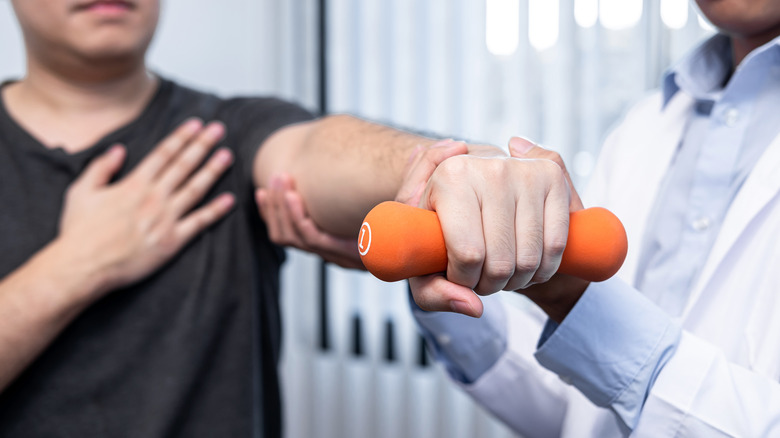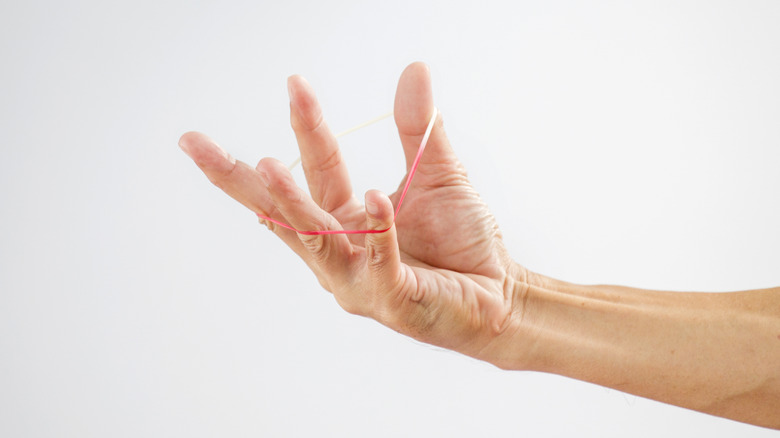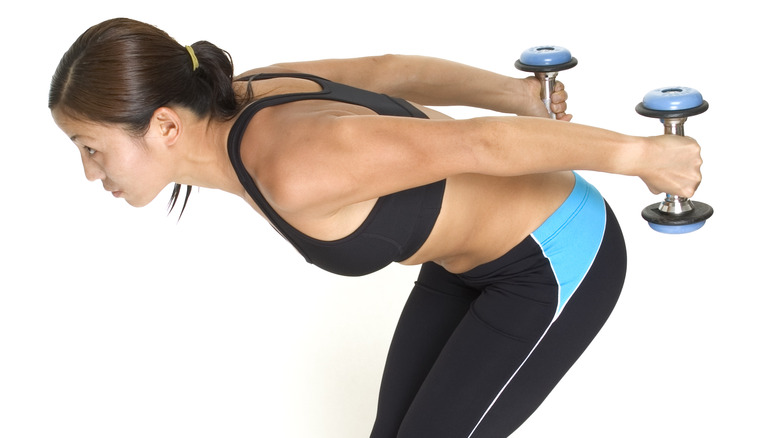7 Exercises To Help Ease Tennis Elbow Pain
Tennis elbow isn't very common. According the Cleveland Clinic, only 1-3% of American adults experience the condition. However, if you're among that population, you know that tennis elbow can be a real pain — literally — and it can make it difficult to work and enjoy your favorite activities. Although tennis elbow can improve on its own with no treatment, it can take a long time so patience is important.
You can speed up the healing and find pain relief with medication and other medical treatments, but you can also do simple strengthening and stretching exercises on your own. Not only will this help to speed recovery, but it will also improve the strength and flexibility in your arm which can help prevent future recurring bouts of tennis elbow. However, before you get started, check in with your doctor to make sure it's tennis elbow you're dealing with, and get the green light to engage in an exercise therapy program.
Causes and symptoms
Tennis elbow, medically known as lateral epicondylitis, is an overuse injury caused by too much force on the tendons that connect muscle to bone (via the Cleveland Clinic). This leads to inflammation, degeneration, and potential tendon tears. While it's common among tennis players who grip their racquets too hard, it can affect anyone who frequently engages in repetitive, vigorous motions involving the forearms. This includes professional and recreational athletes such as baseball and softball players, bowlers, golfers, and squash, pickleball, and racquetball players. It can also affect assembly line workers and mechanics, dentists, butchers and chefs, gardeners, landscapers, painters, cleaners, plumbers, musicians, and manicurists. It's most common in people ages 30 to 50.
Typically, tennis elbow occurs in one arm, on your dominant side. However, it is possible to experience it in both arms, depending on the type of activity you do. The main symptom of tennis elbow is pain that extends from the outside of your elbow to the inside of your forearm and wrist (via the Mayo Clinic). The pain is typically worse when you perform actions such as gripping something or shaking hands, turning a doorknob, or holding a coffee cup. In addition to pain, tennis elbow can cause muscle weakness and fatigue.
Treatment for tennis elbow
In many cases, tennis elbow will resolve on its own. But according to the Cleveland Clinic, it could take as long as 18 months. That's a long time to wait for pain relief. Luckily there are several non-surgical, minimally invasive procedures that can help relieve pain and speed recovery.
Rest is the first line of treatment. Discontinue all activities that aggravate your symptoms for several weeks to enable the tendons to heal. If your work requires use of your affected arm, then this wont be possible. However, you can try to adjust your movements so the injury is less bothersome, or transfer some responsibilities to your non-affected hand. You can also wear a brace to provide more support and stabilize your arm, which can help prevent further irritation.
You can find relief with over-the-counter non-steroidal anti-inflammatory medications like ibuprofen. Corticosteroid injections can also provide temporary pain relief. Other therapies include platelet-rich plasma therapy (PRP), shock wave therapy, and tenotomy, which is a "minimally invasive procedure to remove degenerative tendon tissue from inside your tendon" (via the Mayo Clinic). Physical therapy can also be very effective at not only helping to relieve pain, but rehabilitating the tendon and strengthening the muscles of the forearm.
It's important to note, however, that you should not start exercises in the acute injury phase. Physical therapy should follow a period of rest to allow inflammation to subside (via Healthline).
Flexor and extensor curls
Wrist extension and flexion exercises help to strengthen the muscles on the inside and outside of the forearm. Flexion and extension are opposing movements of the wrist. When you bring the back of your hand toward your outer forearm, that's extension; when you curl your palm down toward your inner forearm, that's flexion (via Research Gate).
You don't need any weight to begin doing these exercises. If you do them in a slow and controlled manner, you will feel your muscles work harder with each repetition. Once you can do this without pain with no weight, then you can use light dumbbells to add more resistance.
Here's how to do it: Hold your arm straight out in front of you, palm facing down. You can also sit and rest your forearm on a table with your hand and wrist extended over the table edge. Keeping the fingers as straight as you can, extend the wrist bringing the back of your hand toward you. Go to the edge of your range of motion, hold for 10 seconds, then lower the hand back to the starting position. Repeat 10 times (via Great Western Hospitals).
Next, flex your wrist so it curls down and your fingers point toward the floor. Move slowly to the edge of your range of motion, pause for 10 seconds, then return to your starting position. Repeat 10 times.
Wrist extensor and flexor stretch
Flexion and extension stretching exercises help increase flexibility in the forearm muscles and mobility in the wrist joint. Flexibility is the ability of a muscle to stretch and contract. Mobility is the ability of a joint to move through its natural range of motion (via Guthrie). Both are important to aid recovery and prevent further complications in musculoskeletal injuries like tennis elbow.
Here's how to do it: Extend your arm out in front of you with your palm facing down. Bend your hand back toward you — extension — as you did in the strengthening exercise. Grasp your fingers with your other hand and begin to carefully pull them toward you as far as you can without pain. You'll feel a stretch along your inner arm. Hold for 15-30 seconds (via UVM Health). Next, flex your wrist so your fingers point down. With your other hand, gently bend the wrist farther until you feel a stretch along the outer forearm muscles. Hold for 15-30 seconds. Repeat the entire exercise two to four times.
Biceps curls
Biceps curls are often a vanity exercise, targeting increased muscle size in the upper arms. But they can also be rehabilitative in the case of tennis elbow. You can use a pair of light weights if you have them, but you can also get creative with household objects, such as soup cans and milk jugs.
Here's how to do the standard biceps curl: Stand or sit holding the dumbbell at your side with your forearm supinated — palm facing forward. Keep your elbow tucked into your side as you curl the weight up toward your shoulder, then lower it back down with control, explains the American Council on Exercise (ACE). Repeat for 2-3 sets of 12-15 repetitions.
If regular biceps curls cause pain, you can try a variation. Hammer curls are performed with the forearm and dumbbell perpendicular to the floor which changes the location of force and can alleviate pain from standard biceps curls (via Healthline). You can also do hammer curls for variety and to target slightly different muscles in the forearm and upper arm. Here's how to do them: Hold the weight at your side with your palm facing in. Keep your upper arm still and curl the weight up toward your shoulder, keeping your palm facing in the whole time. Slowly lower it back down to the starting position (via ACE). Repeat for 2-3 sets of 12-15 repetitions.
Grip squeeze
Tennis elbow can decrease grip strength. According to Ortho Bethesda, grip exercises can help strengthen the flexor tendons and muscles in the fingers and thumb. You can use a rubber ball, tennis ball, or even a balled up sock for this exercise, or you can buy a specialized grip-strengthening tool.
Here's how to do it: Sit down and rest your arm on a stable surface, such as a table, with your palm facing up. Place the ball in the center of your palm, and close your fingers around it. Squeeze it for 10 seconds, then release. Repeat 10 times.
According to Dr. Adam Seidl at Denver Shoulder Surgeon, this exercise should be performed later in your rehabilitation program, after you've been doing wrist flexion and extension stretching and strengthening exercises for a while. If you feel any pain when doing grip strengthening exercises, exert less force with each squeeze to see if that helps. If that doesn't help, choose a different exercise.
Wrist rotation
Wrist rotation exercises help build forearm strength and increase wrist mobility (via Sports Injury Clinic). This exercise should be done in stages, starting with no weight and the arm supported, then progressing to weighted with the arm unsupported (via Denver Shoulder Surgeon).
Here's how to do it: Rest your forearm on a table with your wrist at the edge and your hand extending over the side. Keep your elbow bent to 90 degrees and your palm facing to the side. Slowly rotate your wrist so that your palm faces down, then return to center. Next, slowly rotate your wrist so that your palm faces up, then return to center. That's one repetition. Repeat for a total of 30 repetitions.
If you feel no pain during this exercise, you're ready to advance. Hold 1- to 2-pound weights as you do the same exercise. The next progression is to straighten your arm on the table. The final progression is to elevate your arm off the table, keeping the elbow straight throughout the exercise.
Finger stretch
This exercise strengthens the extensor muscles of the fingers. You can buy a specialized tool for this exercise, or you can just use rubber bands. Using rubber bands allows you to adjust the tension, beginning with a thin, stretchy elastic band and working up to a thicker less stretchy band.
Here's how to do it: Place the rubber band around your fingers and thumb, just above the second knuckle. Slowly spread your fingers apart against the resistance of the rubber band, then bring them back together. Repeat for 3 sets of 10 repetitions (via American Family Physician).
You can isolate fingers, exercising just four fingers, excluding the thumb (via Advocate Aurora Health). You can also isolate pairs of fingers, such as the index and third finger, or thumb and index finger. You can increase the tension of the band to make the exercise more challenging, or you can increase the number of repetitions you do.
Triceps extensions
The triceps muscle group along the back of your upper arm also helps stabilize your elbow. Strengthening this muscle can help prevent further complications from tennis elbow (via BarBend).There are many different triceps exercises. Triceps kickbacks are easy to do at home with elastic bands, light weights, or even with soup cans or other household objects.
How to do it: Hold a weight in your hand and bend your torso to approximately 70-90 degrees. You can rest your other hand on a table to provide stability and support. Keep your elbow tucked into your side and your forearm still as you extend your hand with the weight up and back. Stop when your elbow is almost straight, then return to the starting position with control, explains the American Council on Exercise (ACE). Repeat for 3 sets of 10 repetitions.
Technique is crucial when performing triceps exercises to prevent injury. It's important to keep the elbows tucked into the sides, which will help stabilize the elbow and upper arms. Allowing the elbows to flare out can often lead to pain.
Are exercises enough?
It's not a good idea to try to diagnose and treat tennis elbow yourself, especially if it's causing you pain and affecting your ability to enjoy your normal activities and complete your work. If you have problems moving your arm, your joints are red and swollen, you have a bump or bulge on the elbow, or the pain is severe, you should call your doctor immediately. Your doctor will create an individualized plan based on your specific condition, which may include several treatments in addition to rest and exercise. About 95% of people with tennis elbow can recover without surgery within six to 18 months, according to the Cleveland Clinic.
However, in certain cases surgery may be necessary. According to a 2015 study in Annals of Translational Medicine, surgery may be necessary in cases where exercise, rest, avoidance of exacerbating activities, and pain control methods aren't working. If you do need surgery, the Cleveland Clinic reports that approximately 80-90% of people see improvements in their condition within one year post-surgery.











